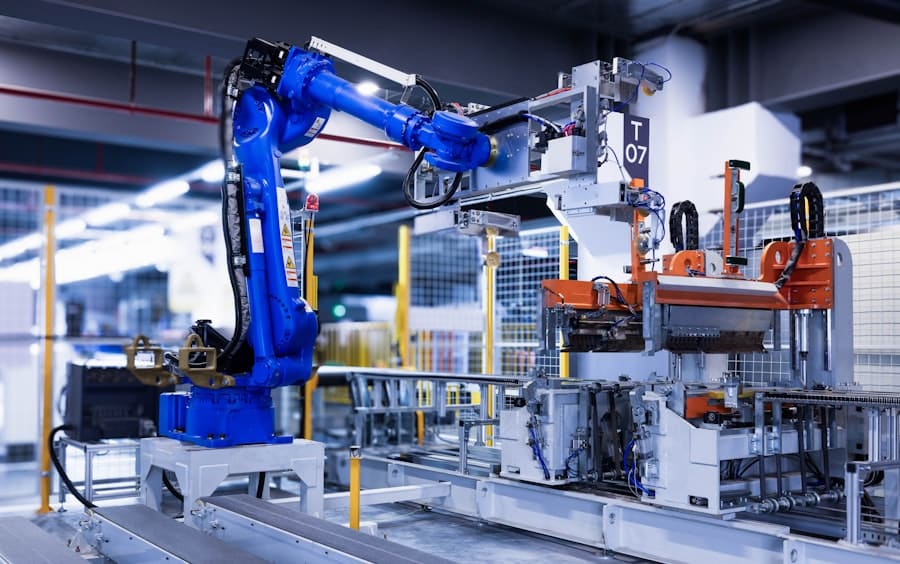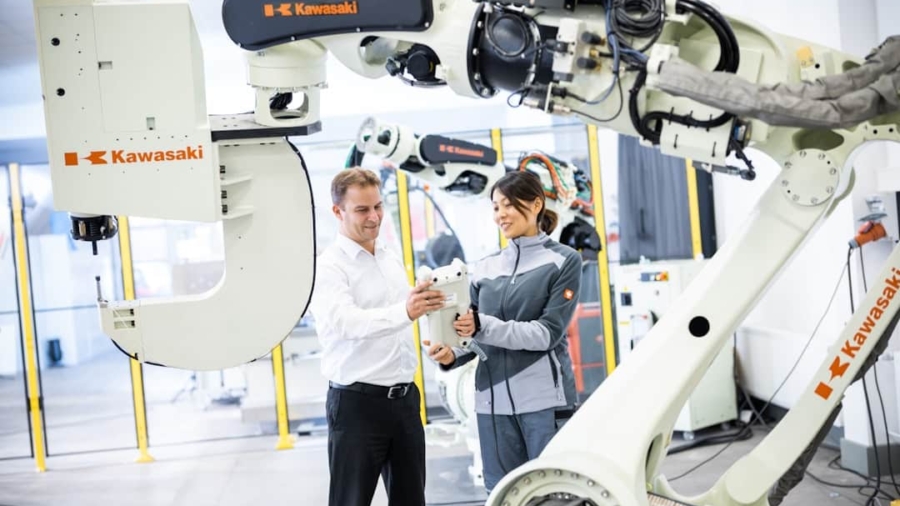The integration of robotics into industrial equipment maintenance represents a significant evolution in how industries manage their machinery and infrastructure. As manufacturing processes become increasingly complex and the demand for efficiency rises, the role of robotics has expanded beyond mere automation of production tasks to encompass maintenance activities. Robotics in this context refers to the use of automated systems, including robotic arms, drones, and mobile robots, to perform maintenance tasks that were traditionally carried out by human workers.
This shift not only enhances operational efficiency but also addresses challenges such as labor shortages and the need for precision in maintenance operations. The adoption of robotics in maintenance is driven by several factors, including the need for increased uptime, reduced operational costs, and improved safety standards. Industries such as manufacturing, energy, and transportation are leveraging robotic technologies to streamline their maintenance processes.
For instance, robotic systems can conduct inspections, perform repairs, and even predict failures before they occur.
Key Takeaways
- Robotics in industrial equipment maintenance improves efficiency and accuracy in maintenance processes.
- Predictive maintenance with robotics technology helps in identifying potential issues before they occur, reducing downtime and costs.
- Remote monitoring and diagnostics using robotics enable real-time monitoring and troubleshooting of equipment from a distance.
- Robotics in industrial maintenance enhances safety by handling hazardous tasks and reducing human exposure to risks.
- Investing in robotics for industrial equipment maintenance can result in long-term cost savings and improved return on investment.
Automation and Efficiency in Maintenance Processes
Automation in maintenance processes has revolutionized how industries approach equipment upkeep. By employing robotic systems, companies can automate routine tasks such as lubrication, cleaning, and inspection. For example, robotic arms equipped with specialized tools can perform repetitive tasks with high precision and consistency, reducing the likelihood of human error.
This level of automation not only speeds up maintenance activities but also allows human workers to focus on more complex tasks that require critical thinking and problem-solving skills. Moreover, the efficiency gained through automation translates into significant time savings. Traditional maintenance schedules often involve planned downtime, where equipment is taken offline for inspections or repairs.
With robotics, many of these tasks can be performed while the equipment is still operational or during off-peak hours, thereby minimizing disruptions to production. For instance, a manufacturing plant might deploy a mobile robot to conduct routine inspections of machinery while production continues uninterrupted. This capability not only enhances productivity but also optimizes resource allocation within the organization.
Predictive Maintenance with Robotics Technology

Predictive maintenance is a game-changer in the realm of industrial equipment upkeep, and robotics technology plays a pivotal role in its implementation. By utilizing advanced sensors and data analytics, robotic systems can monitor equipment conditions in real-time and predict potential failures before they occur. This proactive approach allows organizations to address issues before they escalate into costly breakdowns or unplanned downtime.
For example, a robotic system equipped with vibration sensors can detect anomalies in machinery performance that may indicate wear or impending failure. The integration of artificial intelligence (AI) with robotics further enhances predictive maintenance capabilities. AI algorithms can analyze vast amounts of data collected from various sensors to identify patterns and trends that may not be immediately apparent to human operators.
This data-driven approach enables companies to make informed decisions about when to perform maintenance activities, ultimately leading to optimized maintenance schedules and reduced operational costs. A notable example is the use of drones equipped with thermal imaging cameras to inspect electrical infrastructure; these drones can identify overheating components that may require immediate attention, thus preventing potential failures.
Remote Monitoring and Diagnostics using Robotics
Remote monitoring and diagnostics have become increasingly vital in industrial equipment maintenance, particularly as industries seek to enhance their operational resilience. Robotics technology facilitates remote access to equipment data, allowing maintenance teams to monitor performance metrics from virtually anywhere. This capability is especially beneficial for organizations with multiple facilities or those operating in remote locations where on-site personnel may be limited.
For instance, a company operating wind turbines in a remote area can utilize drones equipped with cameras and sensors to conduct inspections without the need for technicians to travel long distances. In addition to monitoring, robotic systems can also perform diagnostics remotely. Advanced diagnostic tools integrated into robotic platforms can analyze data collected from machinery and provide insights into performance issues or potential failures.
For example, a manufacturing facility might employ a robotic system that can remotely assess the health of its conveyor belts, identifying wear patterns and suggesting maintenance actions based on real-time data analysis.
Robotics and Safety in Industrial Equipment Maintenance
Safety is a paramount concern in industrial environments, where maintenance tasks often involve hazardous conditions or heavy machinery. The introduction of robotics into maintenance processes significantly enhances safety by reducing human exposure to dangerous situations. Robotic systems can be deployed in environments where there is a risk of injury from moving parts or toxic substances.
For instance, robots can be used to inspect confined spaces or perform maintenance on high-voltage equipment, thereby minimizing the risk to human workers. Furthermore, robotics technology can improve safety protocols by providing real-time data on equipment conditions and potential hazards. For example, a robotic inspection system equipped with sensors can detect gas leaks or overheating components and alert operators before these issues escalate into dangerous situations.
By integrating robotics into safety protocols, organizations can create a safer working environment while ensuring compliance with regulatory standards. The use of robotics not only protects workers but also contributes to a culture of safety within the organization.
Cost-Effectiveness and Return on Investment with Robotics

The implementation of robotics in industrial equipment maintenance is often viewed through the lens of cost-effectiveness and return on investment (ROI). While the initial investment in robotic systems may be substantial, the long-term benefits frequently outweigh these costs. By automating maintenance tasks and enhancing efficiency, organizations can achieve significant savings over time.
For instance, reduced downtime due to predictive maintenance can lead to increased production capacity and revenue generation. Moreover, the cost savings associated with robotics extend beyond direct operational efficiencies. By minimizing equipment failures and extending the lifespan of machinery through proactive maintenance practices, companies can reduce capital expenditures related to equipment replacement or extensive repairs.
A case study involving an automotive manufacturer demonstrated that implementing a robotic inspection system led to a 30% reduction in unplanned downtime and a corresponding increase in overall equipment effectiveness (OEE). Such quantifiable results underscore the financial advantages of integrating robotics into maintenance strategies.
Training and Skilled Labor in Robotics Maintenance
As industries increasingly adopt robotics for equipment maintenance, there is a growing need for skilled labor capable of operating and maintaining these advanced systems. Training programs focused on robotics technology are essential to ensure that personnel are equipped with the necessary skills to manage robotic systems effectively. Organizations must invest in training initiatives that cover not only the technical aspects of operating robots but also the integration of robotics into existing maintenance workflows.
Furthermore, collaboration between educational institutions and industry stakeholders is crucial for developing a workforce proficient in robotics maintenance. Technical schools and universities can offer specialized programs that prepare students for careers in this evolving field. For example, partnerships between manufacturers and educational institutions can lead to curriculum development that emphasizes hands-on experience with robotic systems.
By fostering a skilled workforce adept at managing robotics technology, organizations can maximize the benefits of their investments while addressing labor shortages in the industry.
Future Trends and Innovations in Robotics for Industrial Equipment Maintenance
The future of robotics in industrial equipment maintenance is poised for remarkable advancements driven by technological innovations and evolving industry needs. One notable trend is the increasing integration of artificial intelligence (AI) with robotics systems. As AI algorithms become more sophisticated, they will enable robots to learn from past experiences and adapt their maintenance strategies accordingly.
This capability will enhance predictive maintenance efforts by allowing robots to refine their diagnostic processes based on historical data. Another emerging trend is the development of collaborative robots (cobots) designed to work alongside human operators in maintenance tasks. These cobots are equipped with advanced sensors and safety features that allow them to operate safely in close proximity to humans.
This collaboration can enhance productivity by enabling robots to handle repetitive or physically demanding tasks while allowing human workers to focus on more complex problem-solving activities. Additionally, advancements in materials science are leading to the creation of more durable and versatile robotic components capable of operating in challenging environments. For instance, robots designed for underwater inspections or hazardous waste management are being developed with materials that withstand extreme conditions while maintaining functionality.
As industries continue to embrace digital transformation, the role of robotics in equipment maintenance will expand further. The convergence of IoT (Internet of Things) technology with robotics will enable seamless communication between machines and maintenance systems, facilitating real-time data sharing and decision-making processes. This interconnectedness will pave the way for smarter maintenance strategies that leverage data analytics for continuous improvement.
In summary, the future landscape of robotics in industrial equipment maintenance is characterized by innovation, collaboration, and enhanced capabilities that promise to redefine how industries approach equipment upkeep and operational efficiency.
A related article to How Robotics Is Enhancing the Future of Industrial Equipment Maintenance is “Unlock Your Potential with the Samsung Galaxy Book2 Pro.” This article discusses the features and capabilities of the Samsung Galaxy Book2 Pro, a powerful and versatile device that can be used for a variety of tasks, including industrial equipment maintenance. With its advanced technology and innovative design, the Samsung Galaxy Book2 Pro is a valuable tool for professionals looking to enhance their productivity and efficiency in the workplace. To learn more about this cutting-edge device, check out the article here.
FAQs
What is robotics in industrial equipment maintenance?
Robotics in industrial equipment maintenance refers to the use of automated machines and systems to perform maintenance tasks on industrial equipment. This can include tasks such as inspection, cleaning, lubrication, and minor repairs.
How is robotics enhancing the future of industrial equipment maintenance?
Robotics is enhancing the future of industrial equipment maintenance by increasing efficiency, reducing downtime, improving safety, and lowering costs. Automated systems can perform maintenance tasks more quickly and accurately than human workers, leading to improved overall equipment performance.
What are some examples of robotics used in industrial equipment maintenance?
Examples of robotics used in industrial equipment maintenance include robotic arms for cleaning and lubrication, drones for inspection of hard-to-reach areas, and autonomous vehicles for transporting tools and equipment within a facility.
What are the benefits of using robotics in industrial equipment maintenance?
The benefits of using robotics in industrial equipment maintenance include increased productivity, improved safety for workers, reduced downtime for equipment, and cost savings through more efficient maintenance processes.
Are there any challenges associated with implementing robotics in industrial equipment maintenance?
Some challenges associated with implementing robotics in industrial equipment maintenance include the initial cost of investment, the need for specialized training for workers, and potential resistance to change from existing maintenance practices. However, the long-term benefits often outweigh these challenges.

